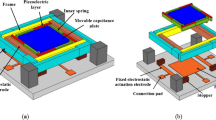Abstract
The paper presents the design, modelling, fabrication and testing of a new electromechanical structure for a tuneable RF MEMS capacitor based on an in-plane torsion generated by the in-plane forces developing during polarization of a parallel plate capacitor with partially overlapping electrodes. The designs explore the possibility to exploit an in plane rotation to extend the dynamic tuning range of a variable capacitor beyond the limits of conventional parallel plate capacitor and to determine the obtainable dynamic ranges and the limitations. These first prototypes adopt a butterfly structure suspended above the fixed electrodes. A small pivot point underneath the center of the mobile electrode acts as rest point after the pull-in and low friction pivot point for the rotation. Different suspension springs have been explored. A first pull-in followed by a parabolic branch with continuous tuning and a second pull-in characterize the C/V measurements. The measurements show a measured capacitance ratio ranging from 1.1 up to 1.6 with a 0–50V bias voltage. The capacitance values measured range from 286 fF up to 687 fF depending on the device type. Theoretical analysis shows that the capacitance ratio can easily be increased by a factor of 20 simply by reducing the initial overlap of the electrodes.









Similar content being viewed by others
Availability of data and materials
Data sharing not applicable to this article as no datasets were generated or analysed during the current study.
References
Rebeiz, G. M. (2003). RF MEMS theory, design and technology. Wiley.
Lysenko Igor, E., Tkachenko Alexy, V., Ezhova Olga, A., Konoplev Borsi, G., Ryndin Eugeny, A., & Sherova Elena, V. (2020). The mechanical effects influencing on the design of RF MEMS switches. Journal of Electronics.https://doi.org/10.3390/electronics9020207.
Kurmendra, K. R. (2020). A review on RF micro-electro-mechanical-systems (MEMS) switch for radio frequency applications. Journal of Microsystem technology., 27, 2525–2542. https://doi.org/10.1007/s00542-020-05025-y.
Persano, A., Quaranta, F., Capoccia, G., Proietti, E., Lucibello, A., Marcelli, R., et al. (2016). Influence of design and fabrication on RF performance of capacitive RF MEMS switches. Journal of Microsystem Technology, 22, 1741–1746. https://doi.org/10.1007/s00542-016-2829-z.
Ture Savadkoohi, P., Iannacci, J., Repchankova, A., & Margeisn, B. (2009). FEM electromechanical modelling of a MEMS variable capacitor for RF applications. In Sensor +TEST conference—SENSOR proceedings II (pp. 253–258).
Bedani, M., Carrozza, F., Gaddi, R., Gnudi, A., Margesin, B., & Giacomozzi, F. (2007). A reconfigurable impedance matching network employing RF MEMS switches. In Proceedings of DTIP (pp. 11–15).
Rebeiz, G. M., & Muldavin, J. B. (2001). RF MEMS switches and switch circuits. IEEE Microwave Magazine, 2, 59–71. https://doi.org/10.1109/6668.969936.
Dussopt, L., & Rebeiz, G. M. (2002). High-Q millimeter-wave mems varactors: extended tuning range and discrete position designs. IEEE MTT-S International Microwave Symposium Digest. https://doi.org/10.1109/MWSYM.2002.1011869.
Tilmans, H. A. C. (2002). MEMS component for wireless communications. In Proceedings of the 16th European conference on solid-state transducers (EUROSENSORS XVI) (pp. 1–34).
Cazzorla, A., Farinelli, P., Sorrentino, R., & Margesin, B. (2015). Reliability test of a RF MEMS varactor based on double actuation mechanism. Journal of Microelectronic Reliability, 55, 1906–1910. https://doi.org/10.1016/j.microrel.2015.07.003.
Maheemed, R., & Rebeiz, G. M. (2010). Electrostatic RF MEMS tunable capacitor with analog tunability and low temperature sensibility. In IEEE conference, microwave symposium digest (MTT). https://doi.org/10.1109/MWSYM.2010.5514843.
Okoniewski, M., & McFeetors, G. (2006). Performance and operation of stressed dual-gap RF MEMS varactors. European Microwave Conference. https://doi.org/10.1109/EUMC.2006.281117
Lee, H. S., Yoon, Y. J., Choi, D. H., & Yoon, J. B. (2003). High-Q, tunable-gap MEMS variable capacitor actuated with an electrically floating plate. In Proc: IEEE micro electromechanical systems. https://doi.org/10.1109/MEMSYS.2008.4443622.
Bagolini, A., Faes, A., & Margesin, B. (2005). Analytical model for magnified displacement stress test structures. In Proceedings of DTIP (pp. 166–168).
Elwenspock, M., & Wiegerink, R. (2001). Mechanical microsensors. Springer.
Giacomozzi, F., Mulloni, V., Colpo, S., Iannacci, J., Margesin, B., & Faes, A. (2011). A flexible fabrication process for RF MEMS devices, Romanian. Journal of Information Science and Technology, 14, 259–268.
Ture Savadkoohi, P., Colpo, S., & Margesin, B. (2010). Novel design of a RF MEMS tuneable capacitor based on elecetrostatically induced torsion. Journal of Microsystem Technology, 16, 1187–1192. https://doi.org/10.1007/s00542-009-0946-7.
Acknowledgements
The present work has been partially supported by the ESA Contract No. ITT AO/1-5288/06/NL/GLC “High Reliability MEMS Redundancy Switch”. The authors wish to thank the members of the MEMS group of FBK-Irst for their valuable support and the many useful discussions. The author want also thank Prof.G.Meneghesso and his group for the help with transient dynamic measurement.
Author information
Authors and Affiliations
Corresponding author
Additional information
Publisher's Note
Springer Nature remains neutral with regard to jurisdictional claims in published maps and institutional affiliations.
Rights and permissions
About this article
Cite this article
Ture Savadkoohi, P., Margesin, B. Tuneable RF MEMS capacitors based on electrostatically induced torsion. Analog Integr Circ Sig Process 110, 431–441 (2022). https://doi.org/10.1007/s10470-021-01948-2
Received:
Revised:
Accepted:
Published:
Issue Date:
DOI: https://doi.org/10.1007/s10470-021-01948-2




